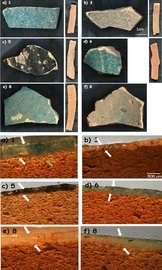Deciphering ceramics manufacturing techniques from the medieval city of Qalhât, Oman.
[sciencythoughts.blogspot.com]
At the beginning of the first millennium AD, the Indian Ocean became a region of long-distance trade between the Middle East, India, South(east)-Asia and Africa, thanks to monsoon winds. The Qalhât site (Sultanate of Oman) located near the Ra’s al-Hadd was a key harbour city for short- to long-distance trade from the 13th to the 15th century. The city was founded around 1100 AD, sacked by the Portuguese in 1508 and becametotally abandoned during the 16th century. More than two hundred thousand ceramic shards have been excavated from this site, and preliminary visual classifications based on shape and decors, as well Raman and X-ray fluorescence studies have been carried out. Many questions are still open for pottery characterised by a simple monochrome glaze and a porous body intermediate between that of terra cotta and faience. There are two well defined groups by visual examination, the so-called ‘Blue speckled’ and ‘Brown speckled’ wares; these are commonly found in many sites of the Arabic Peninsula and their place of production is highly disputed.


Enjoy being online again!
Welcome to the community of good people who base their values on evidence and appreciate civil discourse - the social network you will enjoy.Create your free account
Recent Visitors 14
Photos 292 More
Posted by JoeBKite-like structures in the western Sahara Desert.
Posted by TriphidAn Aussie Indigenous Message Stick.
Posted by TriphidIndigenous Australian Aboriginal Rock art dated somewhere between 20 and 30 thousand years old.
Posted by TriphidIndigenous Australian Aboriginal Rock art dated somewhere between 20 and 30 thousand years old.
Posted by TriphidIndigenous Australian Aboriginal Rock art dated somewhere between 20 and 30 thousand years old.
Posted by TriphidIndigenous Australian Aboriginal Rock art dated somewhere between 20 and 30 thousand years old.
Posted by JoeBDortoka vremiri: A new species of Dortokid Turtle from the Late Cretaceous of the Hațeg Basin, Romania.
Posted by JoeBThe Cabeço da Amoreira burial: An Early Modern Era West African buried in a Mesolithic shell midden in Portugal.
Posted by JoeBMusivavis amabilis: A new species of Enantiornithine Bird from the Early Cretaceous Jehol Biota of northeastern China.
Posted by JoeBTorosaurus in Canada.
Posted by JoeBStone tools from the Borselan Rock Shelter, in the Binalud Mountains of northeastern Iran.
Posted by JoeBDating the Lantian Biota.
Posted by JoeBBashanosaurus primitivus: A new species of Stegosaur from the Middle Jurassic of Chongqing Municipality, China.
Posted by JoeBDetermining the time of year when the Chicxulub Impactor fell.
Posted by JoeBSão Tomé and Príncipe: Possibly the last country on Earth never to have been visited by a working archaeologist.
Posted by JoeBMambawakale ruhuhu: A new species of Pseudosuchian Archosaur from the Middle Triassic Manda Beds of Tanzania.
Members 658Top
Moderator
Related GroupsMore
Religion of Science & Higher Consciousness
77 members
Political Posts, Articles and Memes
169 members
"I was blocked!?" Group
95 members
Conservative Bashers And Progressive Pushers
136 members
Trump Pinata
1142 members
Out Of The Illusion
1742 members
FreeThinkers
2693 members
Progressives, Socialists, and Black/Palestinian Lives Matter
2460 members






